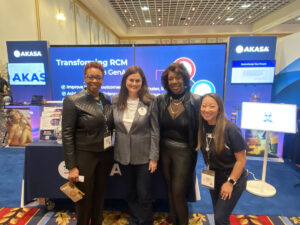The Gist
Generative AI (GenAI) is no longer a futuristic concept. It’s actively transforming revenue cycle management (RCM). At the HFMA Western Region Symposium, leaders from Stanford Health Care and AKASA shared how GenAI is driving revenue, streamlining operations, reducing manual workloads, and improving the patient experience. Rather than replacing staff, AI empowers teams by automating repetitive tasks. Stanford’s phased approach to AI adoption has helped refine processes while minimizing risk, leading to increased productivity, reduced denials, and faster turnaround times. Success depends on choosing the right AI partner and maintaining transparency with staff. Read on for key insights from this groundbreaking discussion.
It wasn’t long ago that generative AI (GenAI) was little more than a concept. Now it’s here, revolutionizing revenue cycle management (RCM) and empowering teams across healthcare organizations. And it was on full display at HFMA Western Region Symposium 2025 in Vegas.
During the session The Promise of Generative AI for Patient Access Teams, industry leaders explored the transformative impact of generative AI on revenue opportunities, productivity, and patient experience.

The panel featured:
- Gebrette Pritchett, MPA, MHSA, VP of Patient Access at Stanford Health Care
- Sharon Lee-Pollard, CPC, CPC-I, Director of Patient Financial Clearance at Stanford Health Care
- Cory Costley, Chief Product Officer at AKASA
Their combined insights painted a compelling picture of how GenAI is delivering tangible benefits to healthcare and the revenue cycle.
“Generative AI is already here,” Pritchett told the audience. “If you’re not already incorporating AI tools into your workflows and revenue cycle, you’re behind.”
Want to learn more about this technology? Here are 10 Things Healthcare Leaders Need To Know About LLMs and Generative AI.
Read on for the top takeaways from the event.
1. GenAI: A Tool to Empower, Not Replace, Staff
GenAI is like no AI you’ve encountered before. It’s an advanced form of technology that can not only read images and text but also generate coherent text and realistic images based on existing data sets. And it’s being rapidly adopted across industries.
“At AKASA, we’re using large language models (LLMs) to unlock the clinical record,” said Costley. “We’re taking LLMs, and we are fine-tuning and refining them to be able to understand clinical context and data to then empower revenue cycle teams.”
Stanford Health Care, for example, is using GenAI to supercharge its revenue cycle processes while maintaining a human-centered approach.
“AI is a tool to complement our staff, not replace them,” affirmed Pritchett. “It’s just another tool in our toolbox.”
She emphasized that at Stanford, AI complements the workforce, enhancing efficiency by taking over repetitive tasks like authorization follow-ups.
“Our teams are asked to do more every day. It’s very time-consuming and requires manual work. The goal is to help staff gain capacity so we can grow alongside our clinics and specialties.”
2. Early Adoption Brings Challenges — and Lessons
Stanford began its AI journey in 2021 and has continually expanded its use of tools like AKASA’s GenAI-powered solutions. Their approach to rolling out AI stands out as a model for healthcare organizations.
“Piloting small helped us identify gaps early on, refine processes, identify issues, and scale,” explained Lee-Pollard.
This thoughtful approach mitigated risks and prepared the team for broader implementation. Piloting GenAI tools on a smaller scale also helped their team identify which gaps needed attention, and ultimately establish processes that would help them with future, broader rollouts of the technology.

3. Choosing the Right Partner
Before you implement AI tools, it’s important to find the right vendor — or vendors — to partner with. Some suggestions from Stanford on what to look for include:
- Goal-focused: Define the specific problem you want to solve
- Flexibility and agility: Find partners who are responsive to customer needs and changes to the business environment
- Scalability and integration: Ensure the solution can scale with your needs
- Data privacy and compliance: Confirm adherence to HIPAA and other regulatory requirements and security measures
“You need a partner who’s going to be flexible and agile as it relates to not just changes in healthcare, but also changes within the organization,” said Pritchett. “And if you’re anything like Stanford, that happens rapidly. You need someone who’s going to be able to flex and move and be agile.
4. Productivity Gains Through Task Efficiency
One of the standout advantages of GenAI is its ability to handle repetitive, manual tasks, allowing staff to focus on higher-value activities. The kinds of tasks RCM is rife with.
For example, Lee-Pollard shared how working with AKASA has allowed the AI to take over repetitive jobs. “This lets our team focus on initiating and submitting authorizations,” she explained. “It has afforded us the opportunity to continue to optimize our workflows and gain efficiencies.”
The resulting improvements to productivity and denial reduction are critical, especially with increasing workloads across specialties. Lee-Pollard added that GenAI has also minimized human error by providing updates faster than traditional processes.
Costley demonstrated the chat-based interface ASAKA offers, which has a data-driven approach that references documents and direct quotes from those documents. If you enter specific information, it provides a high-level synthesis of the answer with supporting data.
“This is revenue cycle teams asking the questions they’re getting asked in the work that they do day-to-day,” said Costley. “It’s the generative AI from AKASA being able to understand the underlying clinical data and the question that’s being asked, and then support that team with the response and the data it used to get to that response.”
And Stanford couldn’t be more excited about this technology.
“I believe it has the potential to be a game-changer,” said Lee-Pollard.

5. Measuring Success With Key Metrics
AI adoption requires clear performance indicators to gauge success. For Stanford, productivity and financial clearance rates have been crucial metrics.
“AI has allowed our team to touch more cases while maintaining a 90% financial clearance rate — our best practice standard,” shared Lee-Pollard. “It really has helped us to forge ahead and get further out in our days out.”
Turnaround times have also improved.
“We’ve seen major improvements in turnaround times and reduced denials,” added Pritchett. “We’ve significantly reduced delays by automating repetitive follow-up tasks.”
6. Collaboration and Transparency Are Critical for Implementation
All speakers stressed the importance of collaboration and transparency in AI adoption. Introducing advanced technology like GenAI can spark fear of job displacement, but Stanford’s leadership prioritized transparency to calm concerns.
“Communicate early and often with your teams and with your stakeholders, and include diverse perspectives,” advised Lee-Pollard. “Be transparent about why you’re using AI. Staff need to know it’s here to help them by reducing repetitive tasks — not to replace their jobs.”
“The toolset is meant to empower teams,” agreed Costley. “And in order to be empowered, there’s an element of awareness that’s needed. You need to work with your teams to talk about GenAI and how it’s used, so they can get familiar with it.”
The panel also highlighted the value of communication with clinical teams.
“Keep clinical partners informed, even about back-end changes,” Lee-Pollard added. Their awareness prevents unnecessary confusion and ensures smoother workflows.
During the Q&A, one attendee asked about the clinical team’s perspective on AI adoption. Pritchett acknowledged that while some skepticism existed early on, the results — such as fewer escalations and faster turnaround times — have fostered trust.
“Clinicians now see fewer last-minute fire drills, which improves both their experience and the patient’s,” she explained. “The proof for them is they have scheduled appointments, the patient has their information, and there are no hiccups.”
It’s not about the technology itself — it’s about results.
7. Preparing for the Future of GenAI
As generative AI evolves, healthcare organizations must adapt. Costley noted that the speed of adoption is incredible — ChatGPT reached 100 million users in just two months.
“You really need to be thinking about GenAI as you’re doing your one-, three-, and five-year plans,” said Pritchett.
During the Q&A, an attendee raised concerns about potential regulations for AI. Costley explained that while no immediate regulations seem imminent, organizations must proactively address issues like bias, data security, and transparency.
“Stanford’s process for evaluating AI tools is an excellent example of preparing for future oversight,” he said.
Read more of Stanford’s best practices for deploying GenAI in healthcare.
Final Thoughts
This dynamic session made it clear that generative AI can no longer be viewed as a futuristic technology; it’s a tangible tool reshaping revenue cycle management today.
“These teams are doing a lot of hard, high-pressure work every day,” said Costley, “and they’re about to get another tool to help them. They may find innovative new ways to be able to use that tool if they’re prepared to be empowered.”
Stanford Health Care’s success shows that thoughtful implementation, strategic scaling, and transparent communication with both staff and clinical partners are essential for maximizing AI’s potential.
As Lee-Pollard aptly put it, “When you know better, you do better.”
To remain competitive, healthcare leaders must embrace this technology as a tool for growth, revenue opportunities, and innovation.
Ready to learn more? Set up a call, and let’s unlock the future of RCM together.

Tiffany Smith is the senior director of content and communications at AKASA. A former magazine editor, she has more than 20 years of experience in content, across healthcare, higher education, and finance, among others.









